In the southwestern region of Iran, amid the vast Khuzestan province, stands an architectural marvel that whispers tales of a bygone era – the Ziggurat of Chogha Zanbil. This ancient wonder, the first Iranian UNESCO World Heritage site, offers a captivating glimpse into ancient Mesopotamia’s rich history and ingenuity. In this article in Parsi Tours Iran travel agency, we will embark on a journey to uncover this remarkable structure’s secrets, history, and allure, inviting you to explore its rich cultural and historical significance.
The History of the Ziggurat of Chogha Zanbil
Dating back to the 13th century BC, Chogha Zanbil is a remarkable testament to the ancient Elamite civilization. Long before the rise of the Persian Empire, the Elamites, with their unique language and culture, left an indelible mark on the region. Their capital, Susa, was a trade, culture, and religious practice hub.
Behind the conception of Chogha Zanbil stands King Untash-Napirisha. It was under his reign, around 1250 BC, that the construction of the ziggurat began. The motivation behind this monumental endeavor was to create a place of worship and devotion that would honor the Elamite god Inshushinak. Inshushinak held a prominent place in the Elamite pantheon, symbolizing fertility, power, and protection.
The ziggurat was more than a physical monument; it was a sacred place where ancient rituals and offerings were made to invoke the blessings of Inshushinak. Its towering presence symbolized a connection between the earthly realm and the divine, a testament to its profound religious significance for the Elamite people.
What is a Ziggurat?
Let’s begin by understanding the essence of a ziggurat. A ziggurat is an ancient Mesopotamian architectural marvel known for its stepped pyramid-like design with sun-dried or fired bricks; ziggurats were primarily religious structures. These impressive monuments symbolized a connection between humans and the divine, serving as spiritual centers and prominent city landmarks.
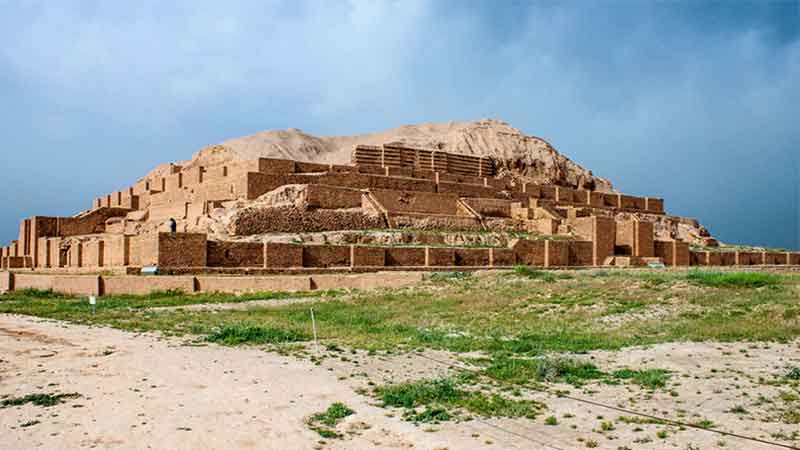
Ziggurat of Chogha Zanbil: Achitecture
The Ziggurat of Chogha Zanbil is undeniably among the most extraordinary ziggurats of antiquity. Its architecture is characterized by a distinctive stepped structure featuring five terraces that decrease in size as they ascend toward the pinnacle. The ziggurat’s base spans roughly 105 meters by 105 meters (344 feet by 344 feet), and it initially soared to an impressive height of approximately 53 meters (174 feet).
However, time has taken its toll, and today, the ziggurat stands at a height of only 24.75 meters (81.2 feet), which is less than half of its estimated original stature. Despite this reduction in height, the Ziggurat of Chogha Zanbil continues to stand as a testament to the architectural prowess and spiritual significance of the Elamite civilization that constructed it over three millennia ago
Sacred Precinct of Ziggurat of Chogha Zanbil
The Ziggurat of Chogha Zanbil held a central position within an expansive sacred precinct, encompassed by formidable mudbrick walls punctuated by grand entrances. The area between the middle and inner walls is known as the “Temenus” or the Sacred Precinct.
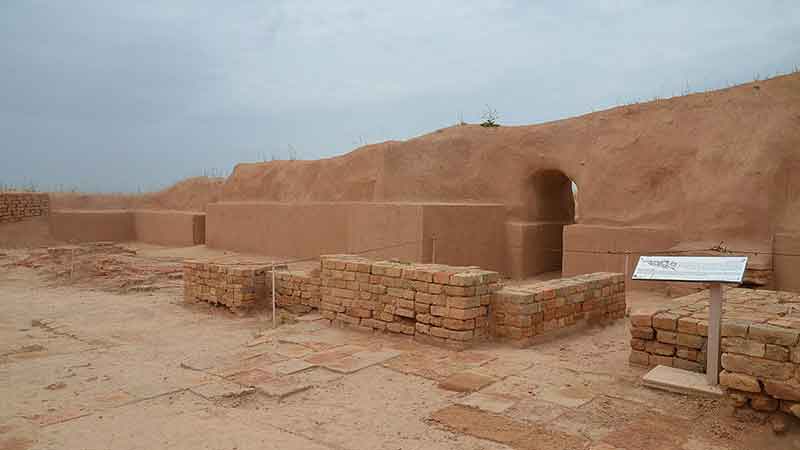
Ziggurat of Chogha Zanbil: temples
Archaeological excavations have unveiled a trove of historical insights within the hallowed precinct. Several temples, each dedicated to specific deities, graced this sacred ground. Many temples in this holy precinct were dedicated to Elamite deities and gods from various cultures, rendering it a place of profound sanctity.
Among the temples, two noteworthy structures with brick facades are the Inshushinak Temple, dedicated to the god of war and protector of the city of Susa, and the Kiririsha Temple, devoted to the Elamite goddess Kiririsha, known for her association with fertility and agriculture.
Cuneiform Inscriptions of Ziggurat of Chogha Zanbil
One of the most captivating features of Chogha Zanbil is the presence of intricate cuneiform inscriptions. The inscriptions of the Ziggurat of Chogha Zanbil are a collection of cuneiform descriptions found on the ziggurat’s bricks. They were written in the Elamite language, providing information about the ziggurat, its construction, and its purpose.
These remarkable inscriptions, unearthed in the early 20th century by French archaeologists, have been meticulously translated and analyzed by scholars. They illuminate the origins of the ziggurat, attributing its creation to the ambitious King Untash-Napirisha during the 13th century BC. Furthermore, they reveal the ziggurat’s divine dedication to the Elamite god Inshushinak.
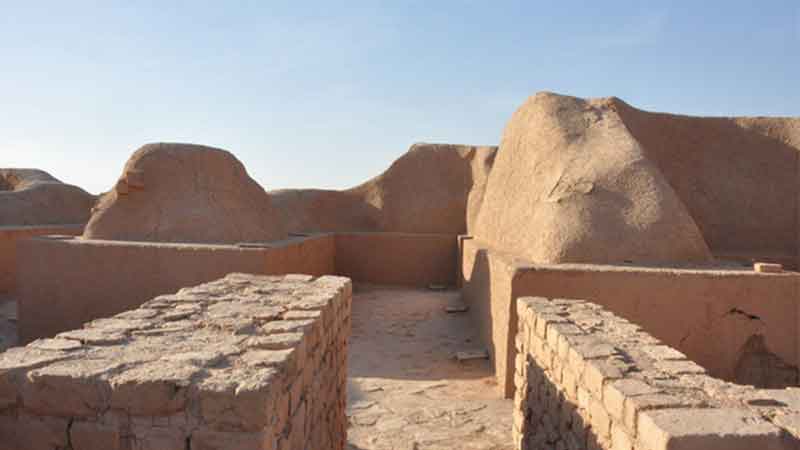
Ziggurat of Chogha Zanbil : Inscription
The inscriptions also provide details about the construction of the ziggurat, such as the materials used and the number of workers employed. In addition to providing information about the ziggurat, the inscriptions provide insights into the Elamite religion. For example, the inscriptions mention the names of other Elamite gods and goddesses, as well as the names of various religious festivals.
In essence, the inscriptions of the Ziggurat of Chogha Zanbil are an invaluable source of information about the Elamite civilization’s grandeur and offer a profound understanding of the Elamites’ way of life, religion, architecture, and culture, making them an indispensable source of historical insight.
Ziggurat of Chogha Zanbil Today
Visiting the Chogha Zanbil Ziggurat today is a journey back in time. You can climb the ziggurat’s steps and stand where ancient people once stood to worship. This experience fills you with a deep sense of wonder and connects you with the past.
Around Chogha Zanbil, there are beautiful palm groves and a peaceful river. These natural surroundings make the historical site even more special. They invite you to appreciate the site’s history while enjoying the beauty of nature.
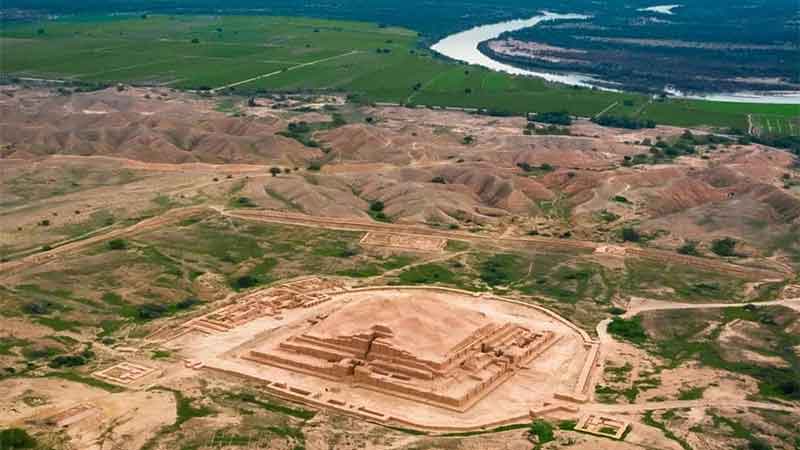
Ziggurat of Chogha Zanbil: Ziggurat view
Chogha Zanbil is essential not just locally but also globally. It has earned the title of a UNESCO World Heritage Site. It means people from all over the world share the responsibility of protecting and preserving it. Discover the efforts to keep this ancient wonder safe for future generations. Chogha Zanbil links us to the past and reminds us to care for our shared history.
Practical Information for Travelers
Chogha Zanbil is one of Iran’s most important archaeological sites and a popular tourist destination. Here is some practical information for travelers to visit the Ziggurat of Chogha Zanbil.
Getting there
The closest airport to Chogha Zanbil is the Ahwaz International Airport (AWZ), which is located about 120 kilometers away. It is situated about 35 kilometers west of Shushtar, near the ancient site of Haft Tappeh; you’ll come across the impressive structure of Chogha Zanbil Ziggurat.
If you take one of the secondary roads from Shushtar to Ahvaz or from Shushtar to Haft Tappeh, you’ll find a sign leading you to Chogha Zanbil Ziggurat. The best way to get to the ziggurat is by car or taxi. Some buses run from Shush to the ziggurat, but the journey takes longer.
When to Visit
The best time to visit Chogha Zanbil is spring (March-May) or fall (September-November). During these months, the weather is mild and pleasant. Summers in Khuzestan can be scorching and humid, while winters can be cold and windy.
Opening hours
Chogha Zanbil is open to the public from 7:30 AM to 7:00 PM, seven days a week. The entrance fee for non-Iranian tourists is 100,000 tomans. You can buy the tickets online or at the site.
There is also a small museum at Chogha Zanbil called Haft Tepe Museum that is worth a visit. The museum has exhibits on the Elamite civilization and the construction of the ziggurat. The entrance fee for that museum for non-Iranian visitors is 50,000 tomans.
Suggested duration
It is recommended to allocate approximately 3 hours for your visit.
What to Wear
When visiting the ziggurat, it is important to wear comfortable shoes and clothing, as a lot of walking is involved. It is also essential to bring sunscreen, water, and a hat, as it can be sweltering and sunny at Chogha Zanbil.
Things to Do
The main attraction at Chogha Zanbil is the ziggurat itself. Visitors can climb to the top of the ziggurat for stunning views of the surrounding area. Several other temples and ruins can be explored at the site. You can also visit the nearby museum to learn more about the Elamites and the ziggurat.
Photography
Remember your camera; you want to capture the stunning moments. Sunrise from the east and sunset from the west aligns perfectly with the temple’s orientation.
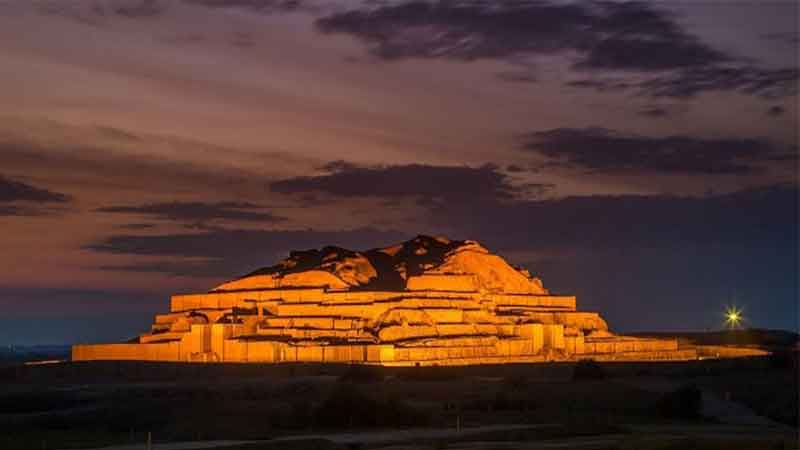
Ziggurat of Chogha Zanbil during sunset
One of the most beautiful scenes at the ziggurat is the sunset. Many tourists have captured numerous photos of Chogha Zanbil during sunset.
Preserving the Legacy
The Ziggurat of Chogha Zanbil is a fragile structure that has stood the test of time for over 3,000 years. However, it is essential to remember that it is still a vulnerable site and responsible travel is crucial in protecting its beauty and significance for future generations.
To protect its historical value, adhere to these guidelines: Stay on designated paths, avoid climbing the fragile mudbrick ziggurat, and respect artifacts and ruins. Respect local culture, and minimize your environmental impact. These practices ensure a positive, sustainable visit.
Conclusion
A journey to the Ziggurat of Chogha Zanbil is a journey through time, offering a profound connection to the ancient world and its mysteries. It’s a place where history, architecture, and spirituality converge, inviting travelers to explore the wonders of Iran’s past and cherish its enduring cultural heritage.



